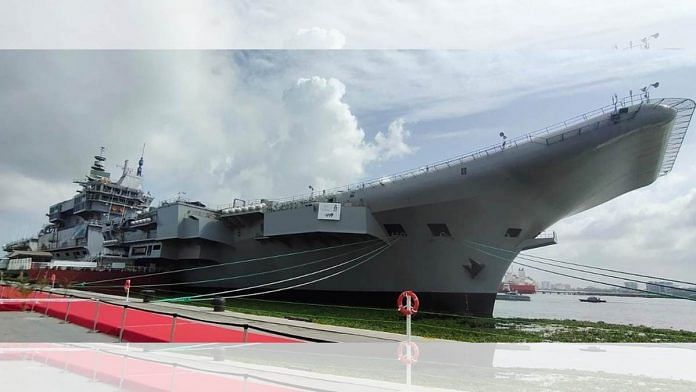New Delhi: India’s first indigenous aircraft carrier (IAC), progress of which was reviewed by Defence Minister Rajnath Singh Friday, will begin its sea trials next month and is set to be commissioned into the Eastern Naval Command as INS Vikrant by mid-2022.
The nearly Rs 24,000-crore project has been hit by delays. While the original targeted year of commissioning was 2018, Covid pandemic contributed to the delay later.
Navy sources said the ship had successfully completed the ‘basin trial’ in November 2020 during which the propulsion and power generation systems the ship in harbour were tested.
Following the trial, the integration of a number of other navigational, communication and operational systems were undertaken.
Though the ship was slated for sea trials earlier this year, it got delayed due to the Covid-induced lockdowns and quarantine process for naval officers and experts coming in from abroad.
Sources said had the sea trials started earlier this year, the ship would have been commissioned by the end of this year.
They said the sea trials are expected to commence in July now and the focus would be on the ‘move’ component of the ship to see how the vessel fares in the water.
If all goes according to plan, the vessel with a displacement of 40,000 tonnes is expected to be commissioned by mid next year, the sources said.
Also read: A second indigenous aircraft carrier is top priority for Navy, says Admiral Karambir Singh
History of IAC 1
Though the original plans for the ship were floated in 1989, the design work began fresh in 1999 after then Defence Minister George Fernandes green-lighted the project that had been stuck due to a number of reasons, including financial resources.
The keel was laid in February 2009. It was floated out of its dry dock in December 2011 and was launched on 12 August 2013.
It has been designed by the Indian Navy’s Directorate of Naval Design (DND) and is being built at Cochin Shipyard Limited (CSL).
Navy sources said the IAC is the most complex warship building project to have been indigenously designed and built.
They explained that while cars, aircraft, tanks are first developed as prototype and after completion of extensive prototype testing, they are replicated in large numbers using the firmed-up supply chain, warships are far more complex to build as they are not prototype-based.
Warships world over therefore are designed as they are built with the full supply chains being defined only at the construction stage, they said.
Combat capabilities of IAC
The IAC is 262 metres long and 62 metres wide and has a STOBAR (short takeoff but arrested recovery) configuration with a ski jump capability.
Once commissioned, INS Vikrant would be the most potent sea-based asset of the Indian Navy.
The carrier would have on board about 35-40 aircraft — a mix of naval fighters, anti-submarine helicopters, and naval UAVs.
The aircraft component includes the MiG-29K fighters, Kamov-31 Air Early Warning Helicopters, the soon-to-be-inducted MH-60R multi-role helicopter and the indigenous advanced light helicopters.
“It would offer an incomparable military instrument with its ability to project air power over long distances, including air interdiction, anti-surface warfare , offensive and defensive counter-air, airborne anti-submarine warfare and airborne early warning,” a source said.
Besides having four OTO Melara 76mm dual-purpose cannons, INS Vikrant is also equipped with four AK-630 close-in weapon systems.
It also has two 32 cell VLS (Vertical Launch System), capable of firing 64 missiles in total. It is equipped with the Israeli Barak 1 surface to air missile for short range and the Barak 8 for long range defence against aerial targets including fighters, helicopters, drones and missiles.
Also read: From INS Vikrant to INS Imphal, how names of Indian Navy ships have evolved over the years



